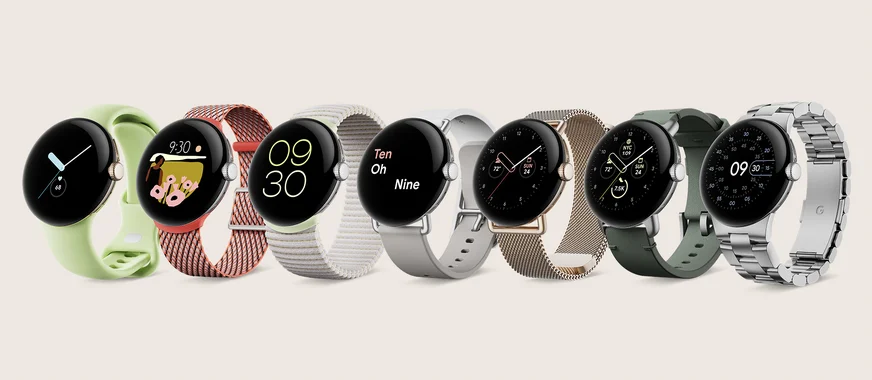For years, rumors swirled about Google creating its own smartwatch. While the company provided the software (Android Wear, later Wear OS) for watches made by partners like Samsung, Fossil, and Mobvoi, a true “Google Watch” remained elusive. That finally changed in October 2022 with the arrival of the Google Pixel Watch, marking Google’s official entry into the wearables hardware space under its own brand.

Since then, the Pixel Watch line has evolved, but its core philosophy remains: to offer a beautifully designed smartwatch that seamlessly integrates Google’s helpfulness with Fitbit’s leading health and fitness tracking, primarily for the Android ecosystem.
A Long-Awaited Debut
Google’s journey to the Pixel Watch wasn’t straightforward. Earlier attempts around 2016 were reportedly shelved. The key catalyst seems to have been Google’s acquisition of Fitbit, finalized in 2021. This $2.1 billion deal brought Fitbit’s extensive experience in fitness tracking hardware, algorithms, and its popular health platform under Google’s roof, providing the missing piece needed to create a compelling smartwatch offering.
Design Philosophy: Minimalist Elegance
From the first generation, the Pixel Watch established a unique and recognizable design:
- Round & Domed: Unlike the square Apple Watch or sometimes more rugged look of other Wear OS devices, the Pixel Watch features a distinct circular case with a domed glass cover that curves smoothly into the metal body (stainless steel initially, later recycled aluminum). Google often describes it as looking like a water droplet or a smooth pebble.
- Understated Sophistication: The design prioritizes minimalism. Bezels are present but aim to blend into the dark background of the OLED display. Interaction points are refined – a tactile rotating crown inspired by classic timepieces and a discreet side button.
- Comfort & Versatility: The smooth, edgeless design is intended for comfortable all-day (and night) wear, easily sliding under sleeves and transitioning aesthetically from workouts to the office to social settings.
- Customization: A proprietary band connection mechanism allows for easy swapping of bands to suit different styles and occasions, complementing the wide variety of available digital watch faces.
Core Pillars: Google Smarts Meet Fitbit Health
The Pixel Watch experience rests on several key pillars:
- Wear OS by Google: It runs Google’s dedicated smartwatch operating system, providing access to notifications, Google Assistant, Google Wallet for contactless payments, Google Maps navigation (including offline maps on the latest generation), Google Calendar, Gmail, YouTube Music, Google Home controls, and access to third-party apps via the Google Play Store.
- Deep Fitbit Integration: This is arguably the Pixel Watch’s biggest differentiator. It leverages Fitbit’s technology for comprehensive health and fitness tracking, including:
- Highly accurate heart rate monitoring.
- Sleep tracking (stages, score, sleep profile).
- Activity tracking (steps, calories burned, Active Zone Minutes).
- ECG app for atrial fibrillation detection.
- Blood oxygen saturation (SpO2) monitoring.
- Stress management features (cEDA sensor on later models).
- Workout tracking (dozens of modes, auto-detection).
- Skin temperature sensing (later models).
- Access to the Fitbit app for detailed analysis and trends, plus Fitbit Premium for deeper insights and guided programs.
- Seamless Ecosystem Play: The watch is designed to work best within the Google ecosystem, offering tight integration with Pixel phones and other Android devices. Features like Find My Device, controlling phone media, and seamless audio switching (with Pixel Buds) enhance the experience.
- Safety Features: Incorporates safety tools like Emergency SOS, Fall Detection, and international emergency calling. Later models added features like Safety Check and emergency location sharing.
Who is the Pixel Watch For?
The Pixel Watch primarily targets Android users (it’s not compatible with iPhones) who are looking for:
- A stylish, premium-feeling smartwatch with a unique design.
- Best-in-class health and fitness tracking integrated directly into their watch, powered by Fitbit.
- Seamless access to Google services like Assistant, Wallet, and Maps on their wrist.
- A capable Wear OS experience with access to third-party apps.
It competes directly with watches like the Samsung Galaxy Watch series within the Android world, offering a different design aesthetic and arguably deeper integration with Fitbit’s platform compared to Samsung Health.
The Journey So Far
From the first-generation Pixel Watch establishing the design and core integration, to the Pixel Watch 2 bringing crucial performance and sensor upgrades, and the Pixel Watch 3 (as of late 2024/early 2025) refining the experience and adding size options, the series has steadily evolved.
In the following articles, we’ll take a detailed look at each generation, exploring their specific features, hardware, software improvements, and how they’ve shaped Google’s vision for wearables. Stay tuned!
